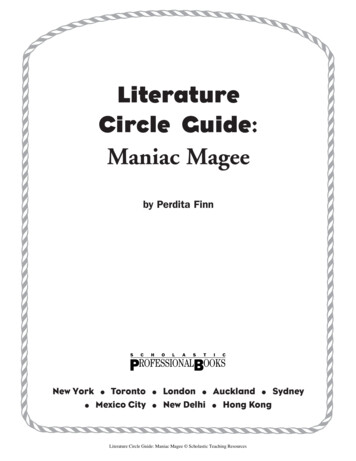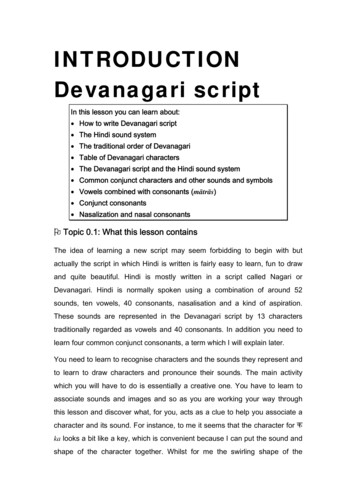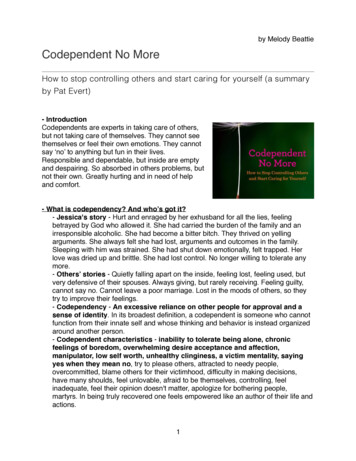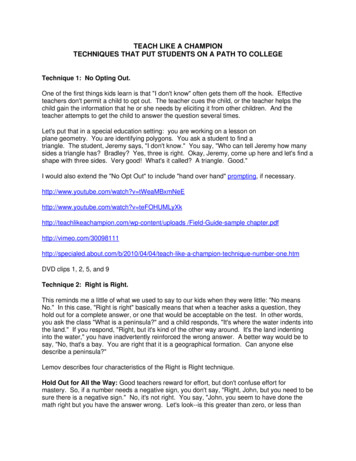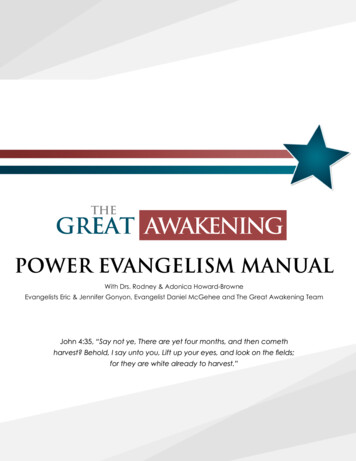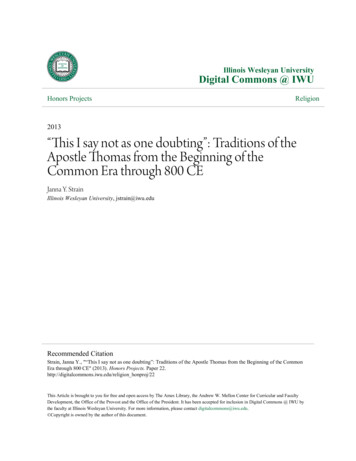
Transcription
Illinois Wesleyan UniversityDigital Commons @ IWUHonors ProjectsReligion2013“This I say not as one doubting”: Traditions of theApostle Thomas from the Beginning of theCommon Era through 800 CEJanna Y. StrainIllinois Wesleyan University, jstrain@iwu.eduRecommended CitationStrain, Janna Y., "“This I say not as one doubting”: Traditions of the Apostle Thomas from the Beginning of the CommonEra through 800 CE" (2013). Honors Projects. Paper 22.http://digitalcommons.iwu.edu/religion honproj/22This Article is brought to you for free and open access by The Ames Library, the Andrew W. Mellon Center for Curricular and FacultyDevelopment, the Office of the Provost and the Office of the President. It has been accepted for inclusion in Digital Commons @ IWU bythe faculty at Illinois Wesleyan University. For more information, please contact digitalcommons@iwu.edu. Copyright is owned by the author of this document.
“This I say not as one doubting”:Traditions of the Apostle Thomasfrom the Beginning of the Common Era through 800 CEJ. Y. StrainReligion 491: Senior Honors ResearchApril 2013Project Advisor: Kevin SullivanCommittee: Dr. Wes Chapman, Professor Nawaraj Chaulagain,Dr. Robert Erlewine, Dr. Kevin SullivanStrain 1
e Gospel of ThomasThe Book of Thomas the ContenderThe Acts of the Apostle ThomasThomas in India12242938Conclusions58GlossaryWorks Cited6368Strain 2
AbstractThe Apostle Thomas survives in Western Christian tradition today as thedisciple who refused to believe in the resurrection without placing his fingers in the holesof his Messiah’s hands. His story is used as a warning for those waiting for the secondcoming: a symbol of those who do not believe Jesus rose again and will look foolishwhen he returns. Thomas is remembered as the disciple you do not want to be, for“[b]lessed are those who have not seen, and yet have come to believe” (John 20:29b).Historically, Thomas has a richer identity. A number of the New Testamentapocryphal texts were named for the “doubting” disciple, including The Book ofThomas the Contender, The Acts of the Apostle Thomas, and The Gospel ofThomas, yet these traditions do not address Thomas’s doubting story from the Gospelof John. In fact, Thomas becomes the favored disciple in The Book of Thomas theContender and logion 13 of The Gospel of Thomas. In The Acts of the ApostleThomas the disciple leaves Rome to evangelize in India where he is eventuallymartyred.Whether or not Thomas actually traveled to India is a debate that will beaddressed in the paper, but it is important to note that a Thomasine Christian traditionhas maintained strong roots in India, especially in the state of Kerala, since at least 372CE and possibly longer. He is still revered in South India as the messenger that broughtChristianity to the country and pilgrims travel to his tomb in Mylapore. As thelongest lasting Thomasine tradition in the world, it is an essential avenue of explorationStrain 3
when considering Thomas’s influence in antiquity.We know that the expanse of the Roman Empire allowed ideas from all overthe Eastern Hemisphere to travel quickly and blend into one another: the massconvergence of thought at the Library of Alexandria demonstrates this phenomenon.Yet despite the unity of ideas across regions, scholars have discussed Thomas in Indiaseparately from Thomas in the Mediterranean aside from the debate over his journey’shistorical legitimacy. This paper would contribute to the field by examining thecontinuity of Thomasine traditions with only chronological boundaries, not geographicalones as is traditionally done with Thomas.This paper discusses the earlier history of Thomas as a religious icon, from hisinitial appearances in the 1st century through its earlier developments in India, andevince not only the historical progression linking those traditions, but also the thematicdevelopment. Because documentation is lacking on groups that used the Thomas textsin Rome, analysis of the traditions in the Mediterranean will be a hermeneutic, deepreading of texts to establish a theological position to which we can assume ThomasineChristians adhered. The Thomasine traditions in India, by contrast, do not have atextual tradition; in fact, texts do not begin to appear in South Indian Christianity untilcolonization in the 16th century. So discussion of Thomas’s history in India willsurround the stories passed through oral tradition, archaeological discoveries, and thescholarly discussion of its history up until this point in time. Moving from the familiarThomas to his Mediterranean origins, to his legacy on the other side of the world, IStrain 4
hope to sketch a concept of Thomas’s cultural identity beyond his moment of doubt andbeyond the common geographical boundaries that scholarship places upon him.Strain 5
MapsChristian Communities ca. 100 CERoman Trade Routes to India First Century CEStrain 6
Northwest India Hypothesis: King Gundaphar’s Coins Found in TaxilaSouth India HypothesisStrain 7
Kerala and the Malabar CoastMylapore in Tamil NaduStrain 8
But Thomas (who was called the Twin), one of the twelve, was notwith them when Jesus came. So the other disciples told him, “Wehave seen the Lord.” But he said to them, “Unless I see the markof the nails in his hands, and put my finger in the mark of the nailsand my hand in his side, I will not believe.” John 20:24 25IntroductionThe Apostle Thomas survives in Western Christian tradition today as a symbolof uncertainty, referred to in contemporary culture not by his Biblical designation,“Thomas the Twin,” but “Doubting Thomas.” His only story in the New Testament is anexample of a disciple one should not emulate for “[b]lessed are those who have notseen, and yet have come to believe” (John 20:29b). Yet since the discovery ofapocryphal codices at Nag Hammadi, Thomas’s reputation has been redeemed, if not inWestern Christian tradition at least in academia. Now with five known texts ascribed tothe apostle Thomas, scholars are attempting to reconstruct his significance forChristianity in the Roman Empire before the texts associated with him were officiallydenounced by the orthodox churches as heretical. Associations to Thomas in antiquitywere clearly problematic enough for the orthodoxy to suppress any mention of him thatwas not demeaning to his faith. Between the castigations of the orthodox heresiologistsand the recently discovered sources they criticized, however, Bible scholars are able toStrain 9
assemble an idea of what legacy Thomas retained in certain Mediterranean Christiancommunities.On a different continent, Thomasine scholarship has developed in a drasticallydifferent form. Since colonization, when the Portuguese encountered the self designatedSt. Thomas Christians in Kerala, India, the academic world has sought to uncover themysteries of its arrival. The unique traditions of South Indian Christianity today havegiven rise to suppositions about its arrival and early development, usually as a methodfor establishing the contemporary churches’ context. While some doubt the arrival ofChristianity in India before 800 CE, different suggestions for its arrival (including thepossibilities of its arrival with traders in the 4th century, with the apostle Thomas on amission to North India, or with him on a mission to South India) suggest differentpossibilities for the nature of the Thomas tradition’s migration into Asia.Discussion of the apostle Thomas has remained regional, working either in theMediterranean or in India, with occasional overlap regarding The Acts of the ApostleThomas. Methodologically, this segregation is understandable: the two regions requiredifferent language skill sets and the resources available for comprehending theMediterranean traditions (primarily textual) require a different sort of interpretiveapproach than the resources available in India (primarily oral traditions and non textualarchaeological findings). Yet at some point during Christianity’s rise, ideas traveledacross the world at the speed that goods were traded. The Pauline epistles show thatwithin twenty to thirty years of Jesus’ death, Christianity had spread as far asStrain 10
Alexandria, Antioch, Corinth, and Galatia through sea trade. The monumentalconvergence of thought at Alexandria by itself is enough evidence to the efficiency ofglobal communication. With the entire known world tied economically to Rome,religion and philosophy traveled and assimilated between cultures rapidly.Once the interchange capabilities are considered, the dissociation betweenThomasine traditions in the Mediterranean with those in India appears to be a massiveoversight. Regional distance at the beginning of the common era was not so vast as towarrant exclusion of one set of traditions from another within the same timeframe. Byanalyzing Thomasine traditions within the constraints of time as opposed to location, onecan organize a map of community values across the Eastern Hemisphere and analyzewhere they maintained integrity and where they morphed and diverged.MethodologyBecause information on ancient Indian Christianity is difficult to date prior to the9th century, the constraints of time will extend through 800 CE with more a moregeneral chronology established for Indian Christian tradition and more detailedchronology laid out for the Mediterranean Christian tradition. Discussion of Thomas’shistory in India will comprise of the region’s oral tradition, archaeological finds, and thescholarly discussion of its history up until this point in time. Analysis of Thomas in theMediterranean will concentrate primarily on the hermeneutics of The Gospel ofThomas, The Book of Thomas the Contender, and The Acts of the Apostle ThomasStrain 11
as well as the condemnations of orthodox heresiologists against the texts and thoseaffiliated with them.1 With general themes established in the separate Thomascommunities, parallels can be identified to define the ancient Thomas legacy.Because this project spans across a few different fields of religious studies, earlyChristianity and Indian religious traditions, many of the terms and locations that arefamiliar to scholars in one field may be unfamiliar with terms from another field. Toavoid confusion over specialized language, I have included a glossary that coversmethodological terms, theological terms, historical people, events, and texts, andcharacters referenced in some of these texts. I have also included maps at the front ofthis paper to provide geographical references. With this list of terms as a resource, Ihope to more easily bridge the gap between religious sub fields when reading thispaper.The Gospel of ThomasPerhaps even before Thomas became the doubtful disciple of John’s Gospel, hewas Thomas the Twin (Didymos) who recorded “the hidden sayings that the living Jesusspoke” (Gospel Prologue). The Gospel of Thomas,2 a non narrative gospel that1Two other texts exist bearing the name Thomas: The Apocalypse of Thomas and The InfancyGospel of Thomas. These texts will not be discussed for reasons of dating. The Apocalypse ofThomas dates in the 9th century without any clear thematic connection with the Thomas texts fromthe first three centuries (Apocalypse of Thomas 645). The Infancy Gospel of Thomas, by contrast,does date in its earliest versions within the time frame under discussion; however, the text was notattributed to Thomas until the 10th century, thereby making it a Thomas tradition morecontemporary to The Apocalypse of Thomas than to The Gospel of Thomas, The Book of Thomasthe Contender, or The Acts of the Apostle Thomas (Chartrand Burke 28).2For the sake of brevity, The Gospel of Thomas will be abbreviated to Gospel; other gospels will beStrain 12
compiles various sayings of Jesus, was written sometime between the mid 1st centuryCE and 140 CE. Arguments for a later composition of the gospel center around thegnostic or pre gnostic themes that can be found in the Gospel (DeConick “On theBrink” 94).3 These opinions were most popular in the 1950’s and 1960’s during earlycriticism of the text, though Richard Valantasis and Risto Uro date it around the sametime as the canonical gospels (Uro 34).4 Most of the recent scholarship on the topic,however, still dates the Nag Hammadi text at about 140 CE; however, it dates theGospel’s earliest version to around the time that Paul wrote his epistles (DeConick94 95, Meyer Secret Gospel 18 19).We do not have much context for the sayings, other than the ones mentioned inthe canonical gospels, but the sayings themselves provide enough information forscholars to make inferences about how it was composed and for whom. Both scholarsMarvin Meyer and April DeConick argue that the Gospel we have today is not theoriginal version of the text and that a core, or “Kernel,” gospel can be derived from it(DeConick “Early Christian Gospel” 113 122 and “On the Brink” 93, Meyer SecretGospel 18 19). DeConick, recognizing the difference in the Gospel’s rhetorical stylefrom the narrative gospel, uses it to inform her reading of the text:Traditionally, we have thought of an ancient “author” as someone whodenoted by their full names, i.e. The Gospel of John.3For a list of scholars and arguments for an earlier dating of Gospel of Thomas see DeConick “Onthe Brink of the Apocalypse,” 94 n. 5.4Uro defends his dating around the philosophical trends of the time, such as Epictetus and theStoics which he believes are more appropriately applicable than gnostic thought to The Gospel ofThomas.Strain 13
collects materials from oral and written sources and edits them together,preserving much of the original source material. . . Within the lastdecade, rhetorical critics have challenged this understanding of theancient compositional process, arguing that the scribal culture that beganto dominate the transmission of ancient Christian literature in the latesecond century has been imposed upon the earlier compositionalperiod. This earlier period, it is argued, is better understood as a“rhetorical culture” enlivened by a creative interaction between oral andwritten composition. It is a culture that uses both oral and writtenlanguage interactively and rhetorically in the compositional process(100).Her reading of the Gospel considers the sayings almost as index cards for a speech:each saying is a marker in a larger sermon. The sayings themselves are not verbatimrecords; “beginnings and endings of the recitations were frequently modified to linksubjects, provide commentary, or extend the argument” (DeConick 102). Sermonswould have been expected to develop with every new recitation, some sectionslengthened, others abbreviated, or embellished with action and interaction with theaudience (DeConick 102).Even without the spoken content, much can be inferred from the existing text ofthese sermons, both the logia that comprised the original text and those added infollowing decades, for later content of the Gospel was influential enough to warrant itsStrain 14
concealment before the advent of the 5th century. If DeConick and Meyer are correctabout the gradual evolution of the Gospel, then communities associated with thisparticular Thomas tradition developed with it. Attention will be given to differentiationbetween the original and revised Gospel, but because of the limited surviving version ofit, most of this analysis will evaluate the general themes found in the text and what valueswould have been held by the community reading.What makes the Gospel ideal for understanding these values is the rhetoricalstructure of the text: the key points of these sermons were about what “Jesus said”about salvation and discipleship. “Jesus functions as the ‘spiritual guide’ of the elect”and in many of these logia gives instructions for salvation (Marjanen 216). Logion 3explains the misguided nature of much salvation seeking: “If your leaders say to you,‘Look, the kingdom is in heaven,’ then the birds of heaven will precede you. If they sayto you, ‘It is in the sea,’ then the fish will precede you. Rather, the kingdom is insideyou and it is outside you” (Gospel 3:1 3). Salvation, according to this passage, is muchcloser than many realize. “Jesus said, ‘One who knows everything but lacks in oneselflacks everything’” (Gospel 67). Furthermore, “If you bring forth what is within you,what you have will save you” (Gospel 70). Salvation, then, is born from within the self,not from the actions of Jesus, as we find in the canonical gospels (Marjanen 217).So with the act of crucifixion salvifically unnecessary, the Gospel must establisha different connection between Jesus and his disciples; Jesus does not identify as asavior, at least in the way orthodox Christianity understands it. He identifies himself asStrain 15
the source of divine enlightenment: “I am the light that is over all things. I am all: fromme all has come forth, and to me all has reached” (Gospel 77:1). This self identificationgives context to Jesus’ identification of his disciples: “If they say to you, ‘Where haveyou come from?’ say to them, ‘We have come from the light, from the place where thelight came into being by itself, established [itself], and appeared in their image.’ If theysay to you, ‘Is it you?’ say, “We are its children, and we are chosen of the livingFather’” (Gospel 50:1 2). What does Jesus say about the chosen elite? In logion 49 hesays, “Blessed are those who are alone and chosen, for you will find the kingdom. Foryou have come from it, and you will return there again” (Gospel 49:1 2).The “chosen” in this final passage have an eternal quality that the canonicalgospels do not ascribe to them. Only in the Gospel of John does the canonacknowledge an eternal nature: “In the beginning was the Word, and the Word waswith God, and the Word was God. He was in the beginning with God” (John 1:1 2).In John’s gospel, Christ’s essence is eternal, but in Thomas’s gospel, so are theessences of Jesus’ disciples. “Jesus said, ‘Blessed is one who came into being beforecoming into being’” (Gospel 19:1). Perhaps Jesus is only blessing himself in thispassage, but every beatitude in the the Gospels of Matthew and Luke are addressed toChrist’s followers. The more likely interpretation of logion 49 indicates an eternalessence of the disciples. Jesus, in fact, does not ever imply his own superiority abovehis disciples. In logion 13, Jesus corrects his disciples about regarding his relationshipwith them by stating, “I am not your teacher” (Gospel 13:5). Marjanen describes theStrain 16
point of this sermon (in this version) to be that “there should be no barrier betweenJesus and his disciples or the elect, whether it be that of a title, or that of power orposition” (216). If the relationship between Jesus and his disciples is not that of ateacher student, then it must be understood in a different form.Perhaps the best way to reconstruct the relationship between Jesus and theChristians of this Thomas tradition is through the study of their asceticism, for thisversion of the Gospel maintains an encratic approach to salvation. Today weunderstand encratism, the belief that absolute sexual abstinence was required forsalvation, through the limited mention of them in the writings of Irenaus, Hippolytus, andEpiphanius (“Encratites” 123 126). “The encratites can only loosely be called anidentifiable sect, having more of the characteristics of a movement that transcends manysects,” states Hultgren and Haggmark (123). Currently there is no information availableon the individual churches that practiced encratism; the heresiologists only discuss thepractice, not the churches that endorsed it.Since the discovery of the Nag Hammadi library, encratism can be understoodthrough the writings attributed to the encratites, not just the denouncements from theorthodoxy. The Gospel available to us, even without the spoken context of thesurrounding sermon, includes enough information in some of the logia that themotivations behind the encratic way of life are more easily deduced. Logion 7 reads,for instance, “Blessed is the lion that the man will eat, so that the lion becomes man.And accursed is the man whom the lion will eat, and the lion will become man”, in whichStrain 17
some scholars like Marvin Meyer interpret “lion” to be a metaphor for “passion”(Gospel Eccles 15 16, Meyer Secret Gospel 29). Jesus also says, “you will say,'Blessed is the womb that has not conceived and the breasts that have not given milk'”(Gospel 79:3). In two different logia, the saying appears, “'Woe to the flesh thatdepends on the soul. Woe to the soul that depends on the flesh'” (Gospel 112:1 2, cf.Gospel 87:1 2). More than in the canonical gospels, in which Jesus’ statements on theissue are generally ambiguous, in the Gospel childbearing and sexuality compromiseone’s spiritual life.The Gospel encourages its audience toward a solitary lifestyle. The secondverse of logion 23 states, “And they will stand as single people,” where “single people”is translated from the Coptic oua ouot, meaning “one alone” (DeConick “Restoration”191, Gospel Eccles 20, Hartin “Search for the True Self” 1007). The word,monachos, which DeConick understands as synonymous to oua ouot,5 is used in otherpassages, such as logion 16:Jesus said, “Perhaps people think that I have come to impose peaceupon the world. They do not know that I have come to impose conflictsupon the earth: fire, sword, war. For there will be five in a house: therewill be three against two and two against three, father against son andson against father, and they will stand alone [monachos].” (Gospel16:1 4)5DeConick “Restoration” 191Strain 18
The word “alone” here literally translates to “the unique ones” which is also interpretedas “solitary,” “monk,” or “virgin” (DeConick “Restoration” 190, Gospel Eccles 70,Hartin “Search for the True Self” 1007). DeConick translates this final phrase as “andthey will stand as celibate people” (“Restoration” 190). According to her, “M. Harl andF. E. Morard have shown in their studies, monachos in [Gospel of] Thomas resultsfrom the Greek translation of the Syriac term ihidaja, meaning single unmarried person,a celibate living in a holy community” (190, Uro “Thomas an Encratite Gospel?”157 158). We see this word appear once more in the context of marriage in logion 75:“Jesus said, 'There are many standing at the door, but those who are alone will enter thewedding chamber'” (Gospel). This passage explains why absolute celibacy is soimportant to the audience of the Gospel: these Christians remain celibate in anticipationfor divine marriage.Not everyone agrees with the encratic reading of the Gospel. Risto Urobelieves the passages typically cited to support an encratic reading are in actuality tooambiguous to attribute an encratic agenda to it. He sees the interpretation asanachronistic, based on comparisons to later Thomasine texts (The Book of Thomasthe Contender and The Acts of the Apostle Thomas), current knowledge of the laterSyrian Church, sparse commentary made by the heresiologists about encratism ingeneral (though not in the context of the Gospel), and a contentious translation ofmonachos (Uro “Thomas an Encratic Gospel?” 156 158). He postulates that theambiguous nature of the language may reflect the ambiguous position that the communityStrain 19
took regarding marriage and sexuality but disagrees with the general association madebetween encratism and the Gospel (Uro “Thomas an Encratic Gospel?” 161). “Thiskind of difference of opinion underlines the difficulties in reconstructing the social contextfor the gospel,” he says (Uro “The Social World” 27). Even DeConick removes themore encratic logia from her evaluation of the earliest Kernel Gospel, indicating thatencratism is suspected to be a later development in this Thomasine tradition (“EarlyChristian Gospel” 113 122).Some scholars also read elements of gnosis, a soteriology based on revealedknowledge in the Gospel. Logion 1 opens the text with “Whoever discovers theinterpretation of these sayings will not taste death,” immediately setting the text in theterms of discovering sacred knowledge (Gospel 1:1). Jesus accuses the Pharisees andscholars of having “taken the keys of knowledge and have hidden them” (Gospel 39:1).He also says that he will “disclose [his] mysteries to those (who are worthy) of [his]mysteries”6 (Gospel 62:1). In logion 13 the disciples try to explain the nature of Jesusand after Thomas admits that he cannot describe him, Jesus takes him aside from theothers and speaks to him secretly. “When Thomas came back to his friends, theyasked him, ‘What did Jesus say to you?’ Thomas said to them, ‘If I tell you one of thesayings he spoke to me, you will pick up rocks and stone me, and fire will come fromthe rocks and consume you’” (Gospel 13:1 8). The sayings to which Thomas refersremain secret to both the other disciples as well as the readers/hearers of the Gospel6Parentheses included for clear translation by translator.Strain 20
sermon. It appears Jesus selects only a few elite to whom knowledge may be revealed.Knowledge, however, is not always revealed; many passages emphasizeachieving gnosis through knowing the self. The third logion states “When you knowyourselves, then you will be known, and you will understand that you are children of theliving Father” (Gospel 3:4). Jesus says in logion 70 “When you give birth to that whichis in you, this what you have will save you. If you do not have that which is in you, thiswhich you do not have in you will kill you” (Gospel Eccles 67). The implication of thispassage is that the only path to salvation requires knowledge of the self, which is onlystated more boldly in logion 67: “Jesus said, 'One who knows everything but lacks inoneself lacks everything” (Gospel 67). “[The Gospel of] Thomas sees the soul or thedivine light in everybody, or at least in all the elect” (Marjanen 217).The accuracy of referring to Thomas as a gnostic gospel is disputed, though,and with good reason. DeConick does not include logia 1, 3, 13, 67, and 70 in heroutline for the Kernel gospel (“Early Christian Gospel” 113 122 and “On the Brink”93).7 Additionally, Uro argues that though there are “Gnostic pleasing” logia in theGospel, a strictly gnostic reading is perhaps insufficient (“The Social World” 34). As aresult, some scholarship has read the text with alternative perspectives on its asceticelements.With both the encratic reading and the gnostic reading of the Gospel beingcontested, Valantasis analyzes many of the more problematic passages of the text,7See footnote 2Strain 21
including many seemingly contradictory ones, in terms of asceticism (but not necessarilyencratism). He understands the Gospel to concern itself less with the method oftransformation and more with the transformation itself:The asceticism relies not so much on the specific renunciatory practices,but rather on the articulation of a newly fashioned self, one inconsistentwith the past, one confidently knowing the all, one new and sufficientlydifferent from the old to be spoiled by contact with it. . . It does notmatter here whether the new self is gnostic or whether the practicesalign with modern understandings of encratism. Only the positiveagenda for creating a newly refashioned self in conflict with the old selfmatters in describing the gospel as ascetical. (Valantasis 63)This interpretation, despite Valantasis’s later dating of the Gospel, is conducive forarguing an early version of the text as a series of sermons more preoccupied withimmediate transformation than with the details of the transformation. DeConick’sevaluation of the Kernel Gospel of Thomas outlines five different speeches, regarding“eschatological urgency,” “eschatological challenges,” “exclusive commitment to Jesus,”“the selection of the worthy few,” and “the imminent kingdom of God” (“Early ChristianGospel” 117 122 and “On the Brink” 105 109). These sermons prioritize theimportance of conversion and what that transformation entails, but the details are notspecifically outlined in the Kernel gospel; explicit instructions would have to beelaborated upon by the speaker (or added into later replications of the Gospel).Strain 22
The more general nature of the Thomas sermons is appropriate for the ministryof the earliest Christians. Many of the Pauline epistles spend extensive time addressingproblems and questions from churches that were not addressed in the initial teachings.Epistles like 1 Corinthians and Galatians illuminate the lack of cohesive teachingbetween the leaders of the Christian movement, as evinced in the disagreement betweenPaul and Peter. Strong theological consensus in the church did not begin to form untilthe Greek apologists. The sermons from the Gospel would not have been teachingspecific ways of life for its audience to adopt.We can postulate at least two different types of communities from thesereadings of the Gospel: an early community more preoccupied with conversion andimmediate transformation, and a later community that specified what values went alongwith that transformation, such as gnosis and encratism. As the Gospel sermonsdeveloped to address the more advanced questions of the community, the text wasrevised to accommodate the more specific theological needs of the community. Sowhile the original text of the Gospel may have corresponded with what eventuallybecame the canon, the Thomas tradition in the Mediterranean rapidly developed a moreradical interpretation of spiritual transformation.The Thomas tradition in India appears to have have evolved from a theologymore akin to the older, original Gospel tradition than the later, more zealous ascetictradition that appears to have developed by the mid 2nd century, for while the historicalvalues of the St. Thomas Christians in India have commonalities with the soteriology
Thomas the Contender, The Acts of the Apostle Thomas, and The Gospel of Thomas, yet these traditions do not address Thomas’s doubting story from the Gospel of John. In fact, Thomas becomes the favored disciple in The Book of
